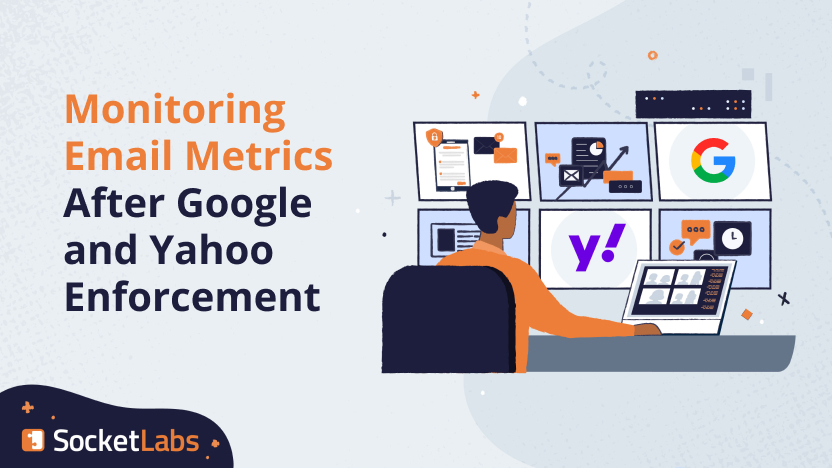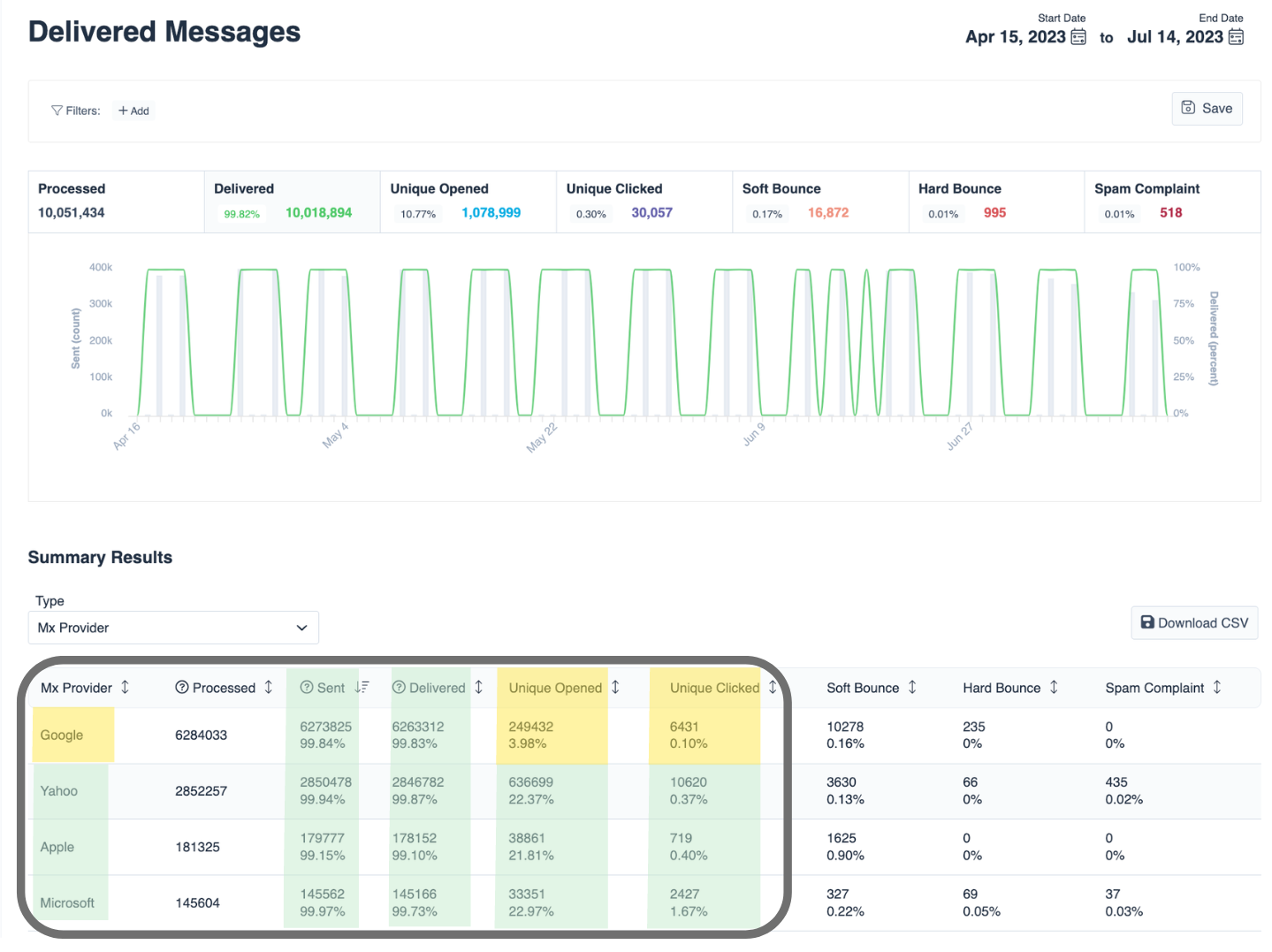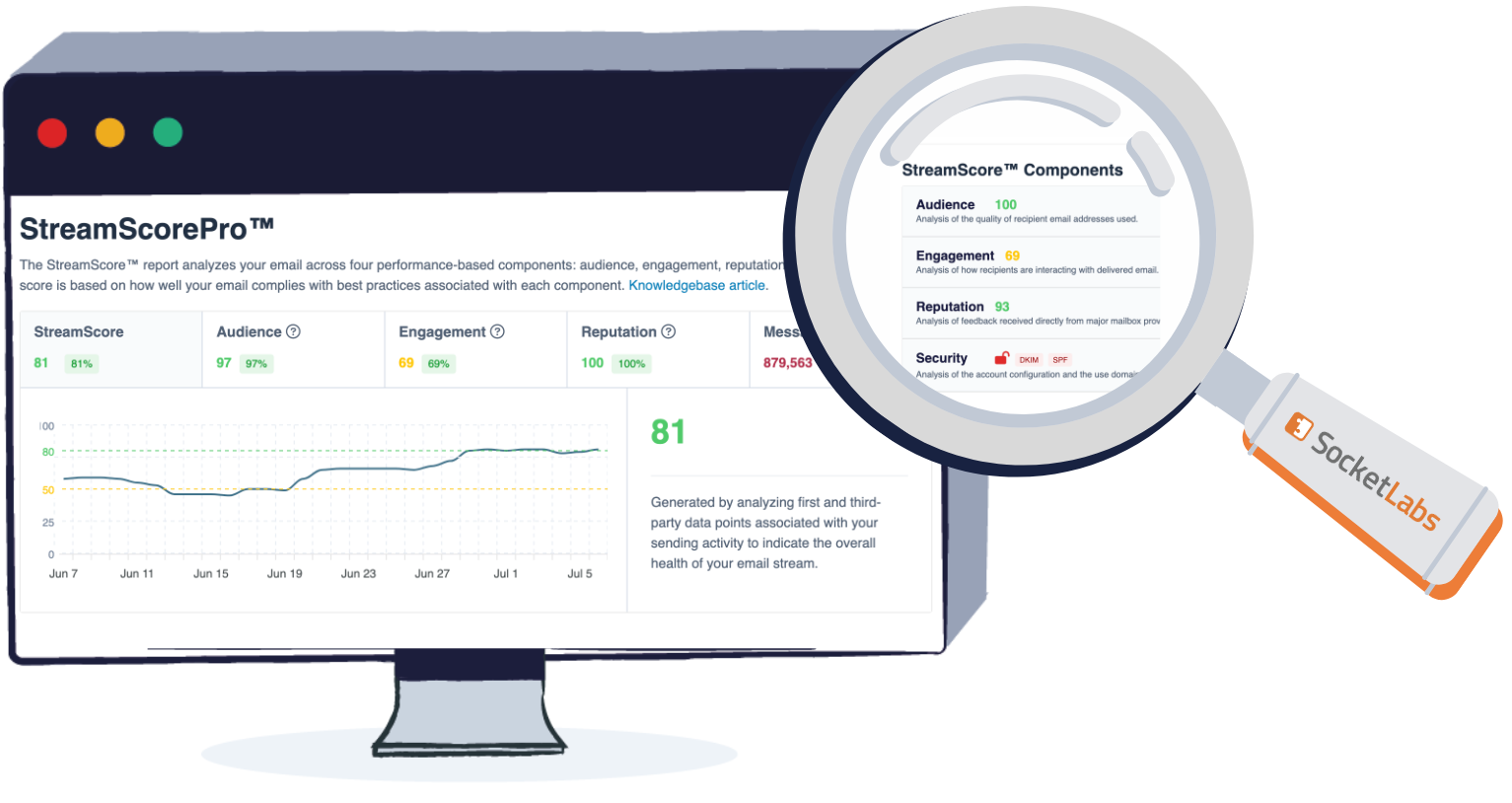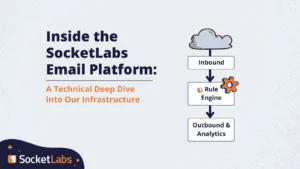
The deed is done: Google and Yahoo’s new requirements are officially in effect (except for one-click list-unsubscribe). Now that we’re less worried about getting prepared, we can turn our attention to monitoring the actual impact of the new rules on your email performance.
We’ve mentioned before you don’t really need to worry about negative consequences to your email program if you’re both adhering to their rules and following best practices. However, this shouldn’t mean you sit back and expect your mail to land in the inbox without fail.
Let’s talk a little bit about what you should be monitoring.
What Should I Be Monitoring?
You’re likely in one of two camps: You follow their rules or you don’t (yet?). We’ll split up the things to focus on based on where you stand today.
I’m Following the Rules
Look at you! Go, you!
Congratulations on getting it together by Google and Yahoo’s deadline. It’s never fun working under duress but you did it, and we are proud of you.
Here are the main email metrics to be monitoring in these early days.
Bounces
Google and Yahoo have started their phased rollout of enforcement with their new sender requirements by deferring non-compliant mail streams. So, starting Feb 1st, if you’re not compliant, you’ll start to see 4xx (or temporary) responses to a tiny fraction of your email.
For example: “421 4.7.32 This mail has been rate limited because there is no DMARC alignment”
This means the mail will likely still get delivered, but it’ll be delayed and take a few retries before the mail makes its’ way to the inbox. If you’re using an ESP like SocketLabs, we handle this retry process for you.
Senders might catch this delay if your campaigns are seeded or if you’re watching engagement metrics closely enough to notice they’re much lower than usual around the time you push ‘Send’ but then tick up later in the day.
By the beginning of April, Yahoo and Google will start rejecting a percentage of non-compliant mail – and this includes compliance with all the requirements they’ve outlined in the email sender guidelines they’ve published, except for the one-click unsubscribe.
Senders have until June 1st to implement one-click unsubscribe without worrying about your deliverability being affected.
With that said, we’ve heard instances where senders are seeing improved performance after adding in the one-click unsubscribe (RFC 8058) recently. Imagine, if you’re making it easier for recipients to unsubscribe, you’re making it less likely that they will mark your email as spam to get it out of their way. Because keep in mind: it doesn’t matter if recipients signed up to hear from you or not, if they think it’s spam, they’re going to mark it as spam, and it will affect your sender reputation. So, the sooner you can implement a one-click unsubscribe, the better.
If you’re noticing more temporary bounces than normal, don’t panic. Even if it’s after April 1 and you’ve got more soft bounces, don’t panic, either, just get yourself compliant! As a refresher, here is a blog about the main differences between hard and soft bounces. Generally speaking, explore your practices around data collection and list hygiene. These are two major contributors to bounced mail.
If you use SocketLabs Spotlight, we’ll surface what could be causing an increase in negative bounce activity. Your StreamScore would start to drop, and with just a little investigation, you might find an issue related to recipient engagement or sender reputation that’s leading to soft bounces.
Opens
Though some folks don’t put too much stock in the value of open rates, they’re still important to watch, especially when you’re looking at opens at the destination level.
By looking at opens at the provider level, you can see the performance at Google and Yahoo without noise from other mailbox providers affecting your open rates. From there, it’s all about the patterns! If you typically have a 25% open rate at Google but this week, you’re averaging closer to 3% on each distribution, something might be afoot. Note not every ESP gives you destination-level information, so we made it a priority to give you that level of detail.

In this conversation, though, we need to have a “let’s get serious” moment. If you see a drop in open rates after getting yourself compliant with all of Google and Yahoo’s authentication requirements, you might have a reputation problem, not a rule-following problem. Typically, properly authenticating will give you the mailbox placement you deserve, and this is dictated by your sender reputation. If your authenticated mail is going to spam, you can assume your reputation now precedes you and you’re being put in spam for a reason.
Keep an eye on it.
Unsubscribes
Though it might be difficult for some bulk senders to swallow, not all spam is malicious in nature. If someone doesn’t want the email you sent, very strictly speaking, it is spam—even if they’ve signed up to receive it. They probably know it’s not intentional spam so they’re less likely to complain about it when they see it, but you want to make it as easy as possible for them to unsubscribe rather than complain.
If you’re noticing an uptick in unsubscribes, this doesn’t necessarily mean you’ve done anything wrong or you’re being harmed by the requirements themselves. People just have the “unsubscribe” button available to them without needing to click into your email, so it’s a lot easier to say, “I don’t shop there anymore” and hit the button. If they are unsubscribing, they’re not complaining, so that’s a win!
However, if you’re noticing this happening at a high volume beyond the first couple of days after implementing a one-click unsubscribe, it might be a sign you’re contacting unengaged addresses that should be pulled off your list proactively.
While unsubscribes aren’t inherently harmful to deliverability, it’s a sign you might be fatiguing your recipients and racking up spam complaints, which are notoriously difficult to track at Gmail.
Spam Complaints
As part of the new rules, Google and Yahoo are requiring senders to maintain a consistent spam value below 0.1%, and never go beyond 0.3%. So first and foremost, it’s important to note 0.3% is not meant to be a target you barely stay under. It should be the absolute max you ever reach.
I know at least some folks tuning in today are thinking “Wow, 0.1% is really low!” But spokespeople from both Yahoo and Google confirmed the majority of reputable senders have spam complaint rates far below 0.1% or 1:1000 recipients, so even though it may seem low, it’s fully possible.
In my experience, mail can start going to the spam folder with spam rates much lower than 0.1%, so my recommendation is to actually aim for 0.03% or lower if you want to reach the inbox consistently.
Yahoo makes monitoring complaints a bit easier since they offer a complaint feedback loop. This means they inform you about specific recipients who have marked your email as spam so you can suppress them from future mailings. And this feedback shows up directly within the spam % in your ESP reporting. (…unless they’ve hidden it from you, those cheeky turkeys.)
Measuring complaints with Gmail, on the other hand, is more challenging because they do not offer a complaint feedback loop like Yahoo does, so you are not informed about specific recipients who’ve marked your emails as spam. The best way to monitor complaint rates with Gmail is to track them within Google Postmaster tools. More on that later.
Spam complaints are something to always watch, honestly. But since they’re now requiring senders to maintain a consistent spam volume below 0.1% and never go above 0.3%, you should be very in tune to how complaints are aligning with unsubscribes. If you notice unsubs are up and spam complaints are down, your changes are working as intended. Less negative engagement that counts against your sender reputation is a good thing, even if that engagement is an unsubscribe rather than a spam complaint.
If you notice your other email metrics look typical but your complaints are up, you should look at your list collection and management processes, as well as your content and frequency. Since complaints are a pretty visceral reaction to email, you could be doing something to agitate to your recipients. Maybe they aren’t expecting your mail because they didn’t sign up to receive it. Maybe the content is different from what they expected or perhaps it’s even off-putting.
It is super important to find the most likely source of friction ASAP, because complaints are very detrimental to deliverability.
Overall Reputation
This is the sum of all the parts. For SocketLabs customers — both senders and Spotlight reporting users alike — you can see your reputation via our StreamScore. We analyze the most important aspects of sender reputation for you to create a number score from not just the things we’ve already covered, but also more than 20 other data points.

For those not using us, you’ll need to do a little number-crunching yourself to get a sense of your reputation. If you’re getting consistent delivery and overall positive engagement, you probably are doing just fine! You shouldn’t see much change now that Gmail and Yahoo are treating bulk mail differently today, aside from potentially seeing a lift in performance as a reward for being a good sender.
Other Data Points To Watch (Outside of Your ESP)
We’ve mentioned this before, but not all ESPs give you all the metrics you need to create the full picture of your performance. Here are a few more things to be familiar with.
- Google Postmaster Tools: If you’re not yet connected to Google Postmaster tools, you can signup here. The process is pretty straightforward and gives you insight into what Gmail thinks of you as a sender. There is quite a bit of nuance though, so check out this article from one of our deliverability experts, Brian Godiksen, as well as Al Iverson’s interview with Google’s Neil Kumaran for the Spam Resource blog. Lots of great insight in both.
- Yahoo Sender Hub: This is new! So new, in fact, it isn’t fully functional yet. You can request access to their beta version, but for now, make sure it’s on your watchlist so you can start using it when it’s ready.
- Seed testing: You can send email to a subset of email addresses to get a directional idea of inbox placement. These are real addresses, so the list should be indicative of the overall mix of domains on your list. To stay true to our topic at hand, focus on a seed list with Google and Yahoo addresses. Is there a delivery delay? If so, you could have a compliance issue, and you should pop into your ESP (or Spotlight!) to look at bounce data, if they provide it.
How To Know If You’re Compliant With The New Requirements
For authentication, specifically, check with your ESP about your compliance status or for guidance with implementation. You can also use this handy tool called About My Email. It was built by Steve Atkins from Word to the Wise. It’s deliverability geek tested, and postmaster approved; a friend at Yahoo confirmed if Steve’s tool says you’re compliant, then you’re compliant.
To use it, you simply send an email from your production environment to the email address it gives you. Once it receives that email it will go through it and do many of the basic checks deliverability folks usually do to check the technical health of a client’s email and displays a detailed report of what it finds, including checks for SPF, DKIM, and DMARC, in addition to other elements of the new requirements. It’s free to use and doesn’t require any signup or information from you other than sending it an email.
What If I’m Late on Following the Rules?
What’s the hold-up? Need a little help? That’s ok!
If you’re running behind, you need to be monitoring all the email metrics above but keep an even closer eye on your delivery, bounces, and engagement.
As these changes continue to be rolled out, you might find your delivery rate slipping based on a lack of DMARC or other requirements. It’s always easier to prevent damage rather than cleaning up a mess.
Stay Vigilant!
That’s our main advice on mostly everything email. Stay compliant with rules, follow best practices, watch your performance (it can be suuuuper easy), and always try to improve the recipient experience with your emails.
When you need a little extra support, you know where to find us!







